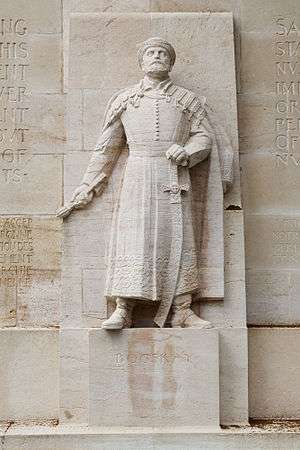Bocskai uprising
The Bocskai uprising (in Hungary Bocskai's War of Independence Hungarian: Bocskai szabadságharc, Bocskai-felkelés) was a great revolt in Hungary, Transylvania and modern Slovakia, between 1604 and 1606 against Rudolf II, Holy Roman Emperor, during the Long Turkish War. The leader of the rebels was István Bocskai, a significant Protestant Hungarian nobleman. The great Ottoman war burdened the Hungarian Kingdom and led to famine and epidemics. The armies of the Christian states also destroyed as the Ottoman and Tatar forces.
| Bocskai uprising Bocskai's War of Independence | |||||||
|---|---|---|---|---|---|---|---|
| Part of the Long Turkish War and the European wars of religion | |||||||
 Bocskai's statue on the Reformation Wall (Geneva, Switzerland) | |||||||
| |||||||
| Belligerents | |||||||
|
| ||||||
| Commanders and leaders | |||||||
|
Rudolf II, Holy Roman Emperor Giorgio Basta Giovanni Barbiano di Belgiojoso |
István Bocskai Balázs Németi † Ferenc Rhédey Sokolluzade Lala Mehmed Pasha | ||||||
| Strength | |||||||
| 40–50,000 | 60,000 | ||||||
Rudolf persecuted the Protestants and the rich Hungarian noblemen were falsely accused of treason. Because of injuries István Bocskai organized the revolt and persuaded the Hungarian military units, the Hajduks, to join. Bocskai defeated the imperial forces and foreign mercenaries, and the Hungarian nobility, the Hungarian soldiers and peasants, and also the minorities went over to Bocskai's Hajduk army. Bocskai was supported by the Ottoman Empire, the Crimean Khanate, Moldavia, Transylvania and Wallachia, but prevented a possible Ottoman siege of Vienna. Bocskai was declared for the Prince of Transylvania and Hungary, but recognized the fact that the challenge of independence of Hungary is not possible against the Habsburg Monarchy and the Ottoman Empire. Bocskai marked the political route for his supporters, namely the preservation of the independent Transylvania, which may be a base for the unification of Hungary.
Prelude
In 1591 the Long Turkish War broke out. All forces of the Habsburg Monarchy (Austria, Bohemia, Hungary, Croatia, Moravia) and join also Transylvania, and the Ottoman vassals states Moldavia and Wallachia. Few European states sending troops in Hungary. The Papal State mostly recruit foreign Walloon and Italian mercenaries for the War. The Habsburg and the Spanish king also employed Walloon mercenaries besides the German, Italian and Spanish soldiers.
In the first interval of the War the Christian forces suppressed the Ottomans, until the Battle of Keresztes (1596), where the Christian forces defeated by the Ottomans. After the battle the war dragged and wears Hungary, Transylvania and Croatia. The corrupted and low Habsburg movement dissipate the military budget and the unpaid mercenaries (particularly the Walloons) foray into Hungary and Transylvania. <-There are problems with this sentence- The Tatar auxiliaries of the Ottoman army carried Barbarian havocs in Hungary. A few thousand men died due to hunger and epidemics.
Causes of the revolt